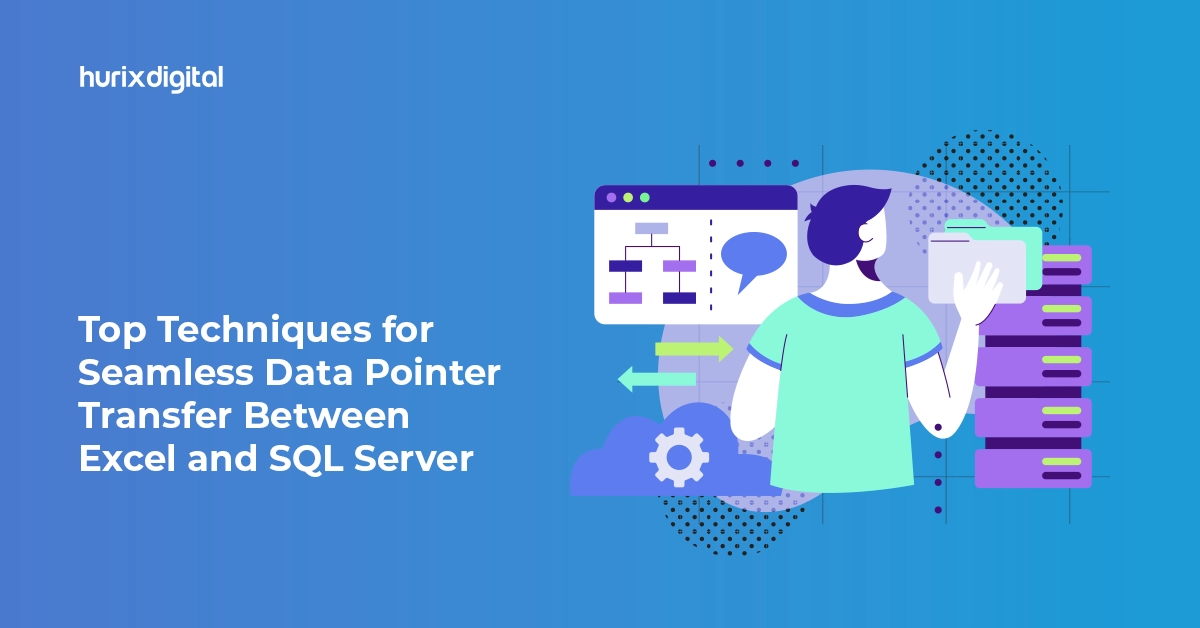
Top Techniques for Seamless Data Point Transfer Between Excel and SQL Server
Summary
Learn techniques for transferring data points seamlessly between Excel and SQL Server. This article offers tips for improving data integration and management processes.
At present, making well-informed and fast decisions about data is the key to success for businesses, to make data transfer quicker and more efficient. One main problem that every organization faces is the challenge of transferring data between Excel and SQL Server. Excel is one of the popular tools for working with data because it’s easy to understand and use for analyzing and presenting data, but it has lots of performance boundaries when it comes to handling large amounts of data or complex queries.
Alternatively, an SQL server is a powerful DBMS that can handle large volumes of Data and complex queries. Customers depend on Excel for data analysis and reporting purposes, but when they try to process large datasets or complex queries to SQL Server, they run into problems. Excel is not made to handle large amounts of datasets or complex queries, and customers may experience slow performance, lots of errors, or data loss when trying to process data in SQL Server.
The Problem in data processing between Excel and SQL Server has become more popular as businesses use data to make decisions. This is the organization’s need to transfer data quickly and accurately between Excel and SQL Server to make sure their information is correct accurate and error-free. As lots of data is being created daily, companies need to have a smooth and easy process for moving data between Excel and SQL Server.
Table of Contents:
- Challenges and Best Practices for Data Transfer between Excel and SQL Server
- How can the Issue be Resolved Using SQL Cloud Services?
- Where can Businesses Find the Solution Using SQL Cloud Solutions?
- Industry Trends in Data Transfer Processes
- Our Two Cents
Challenges and Best Practices for Data Transfer between Excel and SQL Server
Let’s look at the challenges:
- One common issue while moving data between Excel and SQL Server is to check whether the data is formatted correctly or not. The way data is formatted in Excel may not always align with the requirements of SQL Server, sometimes it may cause errors during the data transfer process.
- Excel has its limitations in handling large data, which sometimes may result in performance issues or data loss when trying to transfer a large amount of data to SQL Server.
- Mapping data columns and ensuring data consistency between Excel and SQL Server can be a complex task, especially when dealing with multiple data sources or complex queries.
- Data security is a critical aspect of data transfer processes. It is necessary to ensure that sensitive data is encrypted and protected during the transfer between Excel and SQL Server to prevent unauthorized access to organization data.
Let’s look at the best practices:
- Data Validation: Before planning to transfer data between Excel and SQL Server, it is very important to validate the data to ensure accuracy and consistency. This can help identify any formatting errors or discrepancies before the transfer process begins.
- Use Data Integration Tools: Organizations should use data integration tools like the SQL Import Export Wizard or other third-party tools to make the data transfer process easy and quick. These tools help in automating the transfer process and ensure data integrity.
- Normalize Data: The best practice is to Normalize the data in Excel before transferring it to SQL Server to ensure that it aligns with the database schema. It can help avoid data mapping issues and also ensure that the data is transferred correctly and accurately.
- Monitor Data Transfer Progress: When transferring data, it is important to monitor the process in real-time. It means keeping an eye on how the data is moving from Excel to SQL Server or vice versa. By doing this, they can quickly spot any problems or mistakes that might happen during the transfer. so that it will not create any future hurdles.
Also Read: Exploring the Past, Present, and the Future of IT Managed Services
How can the Issue be Resolved Using SQL Cloud Services?
When an Organization uses SQL on the cloud, it’s very easy to connect with Excel and SQL Server without any complex setups. SQL Import Export Wizards helps customers to transfer data smoothly by guiding them through each step, like selecting the Excel file, and matching columns. They can even view data before transferring to ensure it’s correct or not.
SQL Import Export Wizards supports many data formats, and it is very simple to work with different types of data. They can also schedule automated transfers and track progress in real time. This tool is very simple to use for moving data between SQL server and Excel, it saves time and also reduces error. In conclusion, cloud-hosted SQL with Import Export Wizard is an easy way to make data transfers efficiently.
Where can Businesses Find the Solution Using SQL Cloud Solutions?
SQL Import Export Wizard is one of the tools in SQL Server Management Studio that helps businesses import and export their data between Excel and SQL Server Databases quickly and easily. It is a very good tool with a user-friendly interface, where we can easily choose Excel files and also, we can easily map columns, users can easily select data sources and destinations, and they can even configure advanced settings such as data compression and encryption.
With the help of SQL Import Export Wizard, businesses can transfer their data and avoid manual efforts like copy-pasting data between Excel and SQL Server. It helps to minimize the risk of human error and ensure that data is transferred accurately and efficiently.
Exploring SQL Cloud Solutions like SQL Import Export Wizard can help businesses improve their data management processes, and it helps in enhancing decision-making processes. Businesses can also explore lots of options within SQL Cloud solutions to select the best fit for their specific needs and requirements.
Industry Trends in Data Transfer Processes
In today’s market, most businesses are recognizing the need to efficiently transfer data between Excel and SQL Server. Businesses are moving to tools like the SQL Import Export Wizard to make their data transfer processes easy. Organizations find solutions that are easy to use, reliable, and secure. Today’s trend in the industry is towards using tools like the SQL Import Export Wizard to transfer data between Excel and SQL Server efficiently.
Cloud-based data integration tools are becoming more popular because businesses are storing their data in the cloud. These tools make it easy to connect different types of data source tools like Excel and Microsoft SQL Server. They are flexible, scalable, and cost-effective, secure, making them a popular choice for businesses looking to integrate their data easily.
In the current times, real-time data synchronization is the lifeline of businesses because the market runs on live data, with the help of tools like SQL import export wizard, the information is updated instantly and constantly between Excel and SQL Server, and it is important for businesses because it allows them to quickly access accurate data from either system and make better decisions based on the most up-to-date information available in their system. This helps businesses stay competitive and adapt to changes in the business environment more effectively and securely.
Also Read: What Organizations Need to Know about Cyber Security
Our Two Cents
By exploring these resources, businesses can streamline their data transfer processes and ensure the accuracy and integrity of their information. Choosing the right approach that aligns with your business needs and goals greatly improves efficiency and productivity.
The experts at Hurix Digital can help with your business needs. Contact us to explore the best tools and techniques for processing data between Excel and SQL Server.

DB Consultant – Cloud Services
Saloni is an experienced DB Consultant with strong knowledge of SQL and NoSQL DBs. She is a Certified Microsoft professional for performing complex Database migration tasks and other requirements of clients from different geographical areas. Whenever she is assigned to a task for a technology she is not aware of, she performs it like an experienced professional with her self-learning skills.



